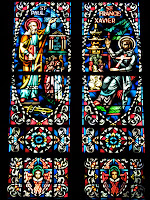Queen of All Saints Basilica
6280 North Sauganash Avenue
Chicago, Illinois
6280 North Sauganash Avenue
Chicago, Illinois
I must give thanks to my friend Derek for indirectly leading to this week's installation of my ongoing church pilgrimage. You see, Derek shares my enthusiasm for ecclesiastic architecture, and had recommended a book on the subject to me nearly a year ago. The title, Heavenly City: The Architectural Tradition of Catholic Chicago, sat scrawled on a piece of paper on my desk for all that time, until I decided to undertake this project and I sought out the book at the Harold Washington Library. Without that book, I never would have discovered this week's church: Queen of All Saints Basilica. To say it is far flung is an understatement -- it's practically in the suburbs, and despite its immense size, it is not visible from any major roadway. Yet, it is one of only three churches in the Chicagoland area officially designated as a basilica-level house of worship by the Vatican.
Queen of All Saints was dedicated in 1960, making it a decidedly large and ambitious project for its time. It was built in the Gothic style, at a time when Gothic, and Gothic Revival architecture had long been eschewed in favor of the clean lines (and cheaper construction costs) afforded by modern architecture. This anachronistic choice was hoped to capture the fervor and devotion inherent to the medieval era in which Gothic architecture was developed, at a time in which parishioners were beginning to stray from the church.
Queen of All Saints was dedicated in 1960, making it a decidedly large and ambitious project for its time. It was built in the Gothic style, at a time when Gothic, and Gothic Revival architecture had long been eschewed in favor of the clean lines (and cheaper construction costs) afforded by modern architecture. This anachronistic choice was hoped to capture the fervor and devotion inherent to the medieval era in which Gothic architecture was developed, at a time in which parishioners were beginning to stray from the church.

Queen of All Saints was elevated to basilica status in 1962 by Pope John XXIII. Basilicas are usually large churches, often, though not necessarily cathedrals, and receive special privileges, such as a special symbols to display in red and gold, the colors of the Papal See, and the presence of a Papal throne at the altar.

The interior of Queen of All Saints was very dim, which certainly evoked the feeling I get when visiting Gothic cathedrals in Europe. I was the only person there, having arrived shortly after the end of confession on a Saturday, and I felt overwhelmed by the scale of the cavernous interior. The ceiling was elaborately painted, although it is hard to tell due to the ambient darkness.

Part of the darkness can be attributed to the lack of light coming in from outside, due to an overcast day, but it was clear that the church was cutting back on their energy costs by not having many of their lights on during non-peak hours. Only about half of the lights were on in the nave, and the lights were actually turned off above the altar by some unseen caretaker while I was in the church. It only added to the spooky, Gothic ambiance.
By far, my favorite part of Queen of All Saints was their stunning stained glass windows, which were beautifully illuminated despite the poor weather. Those in the nave contained images of various saints, keeping in the theme of the basilica's name. The windows in the transept bore images from the life of Jesus. This depiction was undertaken in accordance with the instructions of Vatican II, which asked that newly constructed churches reveal "heavenly realities" through sign and symbol.

Although it did not photograph well, this panel in the baptistery told the story of the church's construction, starting with Columbus bringing Catholicism to the New World, followed by the arrival of the first Catholic missionaries in Chicago, the founding of the Queen of All Saints Parish in 1929, and the designation of the church as a basilica in 1962.
 Above the choir loft is a particularly large window dedicated to the Virgin Mary and her different shrines throughout the world. This is only a detail.
Above the choir loft is a particularly large window dedicated to the Virgin Mary and her different shrines throughout the world. This is only a detail.
In fact, the stained glass windows at Queen of All Saints made it worthwhile to wake up at 7:30 in the morning on a Saturday to drive there. (Yes, I had to drive, because this church is so remote it isn't even accessible by public transportation, despite technically being in Chicago's city limits.) Even if the rest of the basilica was dark, a little dreary, and full of 1960s decorative touches that looked like they could have come straight from the home of someone's grandparents, the windows fully realized the building's intent of capturing the glories of heaven in visual form. Just another hidden gem in the religious world of Chicago, accessible only to those who actively seek them out.


No comments:
Post a Comment